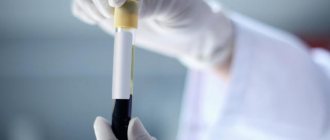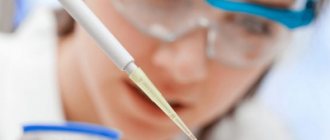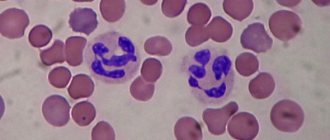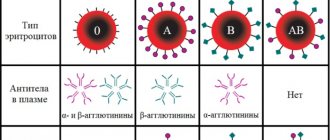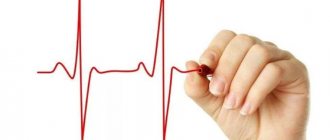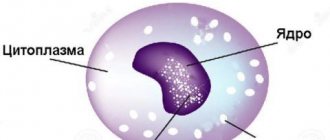Does an increase in red blood cells in the urine always mean the development of a disease?
The detected increased content of red blood cells in the urine often indicates the development of pathology. Designed to supply the body with oxygen and protect it from toxins, their significant increase in urine is often one of the important indicators indicating serious disturbances in the functioning of the body.
Normally, in an adult man and women, red blood cells should not exceed 2 units. But this does not mean that these indicators can be unchanged relative to the norm. In fact, their presence in urine is not necessary. In fact, in many healthy people they are not detected in the urine, and this is also normal.
It is worth knowing that an increase in red blood cells does not always mean the development of the disease. Their number may be increased for reasons unrelated to health.
Despite the fact that doctors primarily consider an increased number of red blood cells as a symptom indicating the development of the disease. An increased content of red blood cells in the urine can be caused by completely different reasons:
- Abuse of ascorbic acid;
- Frequent intake of highly concentrated sour juices;
- Heavy physical activity;
- Frequent consumption of food containing many spices and salt.
These reasons can provoke an increase in red blood cells in the urine, both in adults and children. Red blood cells in the urine can also become elevated if you take certain medications for a long time, in the form of sulfonamide or antibiotics. Therefore, to ensure that the result is not erroneous, it is recommended that before taking the test, replace the medications with those that will not affect the content of red blood cells in the urine. Sometimes even a healthy person may have increased red blood cells in the urine, but their excess is insignificant and is temporary.
Triglycerides in the blood are elevated: diet
Diet for elevated TG
Triglycerides play an important role in human health. They are derivatives of glycerol, which serves as a source of energy for the good and proper functioning of the body's cells. These substances are of great importance in the body's fat metabolism.
What to do if the triglyceride level in the blood is elevated?
- You need the right diet.
- The main mistake of almost every person who has elevated lipids is excessive consumption of fats and sugars. This may cause weight gain.
- In your diet you need to avoid fatty and fried foods.
- You should also reduce your consumption of bread and pasta.
- It is better to eat products made from wholemeal flour. It will prevent the concentration of harmful fats in the digestive tract.
Unfortunately, you will also have to part with the cakes. It is better to replace sweet confectionery, as well as ice cream, jam and caramels, with fruits, for example:
- Grapes, which are good for the heart.
- Figs, which fight against neoplasms.
- Bananas, which will improve the functioning of the gastrointestinal tract.
- Persimmon is a real storehouse of vitamins.
Tip: You can drink compotes made from fresh seasonal fruits, but do not add sugar to them. If you cannot drink unsweetened tea or compote, then add a little honey or sugar substitutes: sorbitol, fructose.
Here are some more useful tips:
- It is also advisable to eat less food of animal origin.
- Lean more on fresh, seasonal vegetables and fruits.
- You can eat lean fish.
- Instead of mayonnaise, use natural yogurt, low-fat sour cream and olive oil.
- Stop smoking and strong alcohol.
- Green tea - you can drink it as much as you want.
- Infusions of herbs - mint, ginger - will also be useful.
- You can add cloves, marjoram, basil to your food and drink sage tea.
The main evidence that your TG levels have returned to normal is weight loss. If you needed to increase this indicator when it was too low, then you will notice an improvement in clearer skin, improved well-being and normalization of appetite.
What do elevated red blood cells mean?
Depending on how many of them were detected, the doctor first determines the type of hematuria:
- Microhematuria means that the increased content of red blood cells does not appear. that is, in the urine the color and transparency remain unchanged;
- Macrohematuria, it manifests itself in the color of urine, giving it a red or brown tint. When studying such an analysis, the identified red blood cells may not even be countable.
Gross hematuria is found more often in people over 40 years of age. In most cases, its appearance is accompanied not only by urine that has changed color, but also by pain in the areas where the inflammatory process occurs. There are 3 reasons, conditionally divided into types, for which macrohematuria develops:
| Somatic | Reduced blood clotting, toxin poisoning, infectious diseases. In these situations, the kidneys are only reactive elements that take an indirect part in diseases that are not related to them. |
| Rental | Relates to the kidneys. Tumors, urolithiasis, kidney disease. |
| Postrenal | Genitourinary system. |
Blood test for rheumatoid factor - what is it?
To test blood for rheumatoid factor, blood is taken from a vein. Before donating blood, you must avoid drinking alcohol, smoking, and exercising 12 hours before the test. During this period, you should not drink tea, coffee and sweet drinks, but clean water will only be beneficial. It is advisable to stop taking any medications for a while. If this is not possible, you should tell your doctor what medications you have taken recently. The test is taken on an empty stomach; it is advisable to rest for 10–15 minutes before taking blood.
Venous blood is taken to test for rheumatoid factor.
As a rule, RF is studied in combination with two other indicators - CRP (C-reactive protein) and ASL-O (antistreptolysin-O). The determination of these indicators is called rheumatoid tests, or rheumatoid tests.
A referral for a study of rheumatoid factor in the blood is usually given by a traumatologist, rheumatologist or immunologist.
In addition to rheumatoid tests, the following additional studies may be prescribed to diagnose systemic diseases and other immunological pathologies:
- a general blood test with a detailed leukocyte formula - allows you to identify the inflammatory process in the body and tumors of the hematopoietic system;
- ESR (erythrocyte sedimentation rate) - its increase is also a marker of inflammation;
- biochemical blood test - in particular, the level of uric acid, the amount of total protein and the ratio of its fractions are important;
- anti-CCP test (antibodies against cyclic citrullinated peptide) - allows you to confirm the diagnosis of rheumatoid arthritis;
- determination of antibodies to cellular organelles.
How and why does an adult develop gross hematuria?
?1386669893
Regardless of whether macrohematuria develops in men or women, the symptoms in both cases are unchanged. There are 7 signs in total, each of which can indicate an excess of red blood cells in the urine in an adult:
- Oligoanuria. A sharp decrease in the volume of daily urine or even its absence;
- Fast fatiguability. Constant weakness, fatigue, decreased ability to work;
- Shortness of breath;
- Pain in the lumbar region, lower abdomen;
- Frequent thirst;
- Decreased appetite;
- Vomiting, frequent nausea.
Normal triglyceride levels for men, women, children
Fat metabolism has its differences in people of different ages and gender. The norm of triglycerides, like cholesterol levels, has its own age and gender differences. Lipid profile results may vary between laboratories due to different methods for determining the content of neutral fats.
Table. Normal triglyceride levels for children, men, women.
| Age, years | Floor | Triglycerides, mmol/l |
| 5-10 | m | 0.34-1.12 |
| and | 0.40-1.23 | |
| 10-15 | m | 0.36-1.40 |
| and | 0.42-1.47 | |
| 15-20 | m | 0.42-1.66 |
| and | 0.44-1.39 | |
| 20-25 | m | 0.5-2.26 |
| and | 0.41-1.47 | |
| 25-30 | m | 0.52-2.80 |
| and | 0.42-1.62 | |
| 30-35 | m | 0.56-3.00 |
| and | 0.44-1.69 | |
| 35-40 | m | 0.61-3.61 |
| and | 0.45-1.98 | |
| 40-45 | m | 0.62-3.60 |
| and | 0.51-2.15 | |
| 45-50 | m | 0.65-3.69 |
| and | 0.52-2.41 | |
| 50-55 | m | 0.65-3.60 |
| and | 0.59-2.62 | |
| 55-60 | m | 0.65-3.22 |
| and | 0.62-2.95 | |
| 60-65 | m | 0.65-3.28 |
| and | 0.63-2.69 | |
| 65-70 | m | 0.62-2.93 |
| and | 0.68-2.70 |
In newborns, TG levels are 20% lower than in adults. As you get older, the concentration of neutral fats in the blood increases. An increase in triglycerides in children is an alarming symptom; these children are at risk of developing early heart and vascular diseases. Most often, high triglycerides are recorded in overweight children, lovers of flour and fast food.
What does it mean if there are red blood cells in the urine?
Normally, in a person without abnormalities in health, the number of red blood cells in the urine does not exceed 1-2 cells in the field of view of the microscope.
There are microhematuria - when red blood cells are not visible to the eye, but are detected under a microscope, and macrohematuria - the color of urine changes, which depends on the amount of blood that has entered.
In women, the urethra and vagina are located quite close to each other. Therefore, if a urine test reveals an increase in blood cells, then it would not be amiss to repeat the analysis, but obtain the material for the study using bladder catheterization. If there are no red blood cells in the urine, the woman should be referred to a gynecologist to identify pathologies of the reproductive system.
Red blood cells in urine under a microscope
Changing blood group in pathological conditions
Potentially, the blood type and Rh factor can also change in various genetic and infectious diseases that lead to hematopoietic disorders and direct damage to red blood cells:
- Blood diseases (thalassemia);
- Bone marrow tumors (leukemia, hemoblastosis, hematosarcoma);
- Viral infections (HIV and AIDS, viral hepatitis);
- Bacterial infections (plague, yellow fever, typhus);
- Parasitic infections (malaria);
- Poisoning with chemicals (nitrates, nitrites, aniline dyes, acids, ethers, gasoline, ethyl alcohol).
The red blood cells of each person have individual sensitivity to the listed damaging factors. Therefore, in such diseases, changing the blood group or Rh factor is possible, but not mandatory . However, such changes are temporary. After recovery, the hematopoietic system should produce full-fledged blood cells that a person had before his illness.
Causes of High Red Blood Cell Count
Red blood cells increase in a woman’s body in response to many diseases; for convenience, the reasons are divided according to the level of damage:
- Renal - an increase in red blood cells may indicate damage to the kidney tissue in a woman.
- The content of red blood cells in excreted urine increases as a result of postrenal causes, and the urinary organs suffer.
- Somatic factors: an increase in red blood cells is an indirect sign of a disease not related to the kidneys.
Possible reasons for the increase in red blood cells in the urine at the renal level:
- Traumatic injury. This may be a wound reaching the kidney tissue, a rupture of the kidney capsule. In this case, the bleeding will be massive, the presence of blood in the urine is visible to the eye.
- Glomerulonephritis (acute or chronic). By its nature, the disease is immunoinflammatory: the immune system attacks its own structures, and the glomeruli of the kidneys take the hit.
- Neoplasm of the kidney. As the tumor grows, it damages the structures of the kidney along with the vascular bed; a high number of red blood cells are found in the urine due to slight bleeding as a result of tissue injury.
- Urolithiasis disease. The basis is a violation of metabolic processes. Gradually, the salts, which at first resemble sand, turn into stones, whose uneven edges can damage the mucous membrane and thereby cause bleeding in a woman.
- Pyelonephritis. Infection is not uncommon; often the acute inflammatory process becomes chronic. The permeability of the renal vessels increases, therefore, formed blood elements, including red blood cells, enter the bloodstream through diapedesis through the wall.
- Hydronephrosis. The passage of urine in a woman is disrupted under the influence of various factors, so the structures of the kidney increase. The vessels may not keep up with the tissues: the wall becomes thinner and, ultimately, ruptures. One of the manifestations of this condition may be an increased number of red blood cells in the urine.
By postrenal level of involvement it is meant that the cause of the increased red blood cell count lies below the renal system. These are the urinary tract, mainly the bladder and ureters:
- Cystitis. By increasing the permeability of blood cells through the vascular wall, red blood cells penetrate into the organ cavity and are excreted together with urine.
- Stones located in the urethra or bladder. They scratch the mucous membrane, forming microtraumas on it.
- Injuries of the urinary organs of various types.
- Tumor growth in the bladder cavity or in the lumen of the ureters. The vessels are destroyed, which is why bleeding occurs. Blood loss depends on the size of the damaged vessel.
Treatment to reduce levels
First of all, the choice of treatment depends on the cause that caused the presence of a large number of red blood cells in the urine.
- For inflammatory diseases, therapy is prescribed aimed at eliminating the pathogenic agent. First of all, these are antibacterial drugs, the selection of which is carried out taking into account the results of sensitivity culture. Anti-inflammatory drugs can alleviate the patient's condition. These include Nimesulide, Ibuprofen and others.
- The daily volume of fluid is most often limited. This is done to reduce the load on the kidneys.
- If hematuria is accompanied by edema and other congestion, then diuretics are prescribed.
- Diet if the main factor in the increase in red blood cells is spicy food. A week later the test is retaken.
- In case of traumatic injury or neoplasms, surgical treatment is performed.
- Symptomatic treatment involves the prescription of painkillers, antispasmodics and other drugs, depending on the concomitant clinical hematuria.
Prevention measures
Everyone knows that it is easier to prevent pathology than to treat it diligently later. In order to prevent the appearance of an increased content of red blood cells in a urine test, you must follow some rules:
- Maintain drinking regime. Drink at least 1.5 liters of water for adults (in the absence of pathologies for which heavy fluid intake is undesirable).
- Do not overload the body with excessive sports or hard work.
- At least once a year, have your urine analyzed for early detection of an increase in the number of red blood cells.
- Rational, balanced nutrition.
- Do not self-prescribe medications, especially antibacterial drugs: against this background, the disease progresses smoothly, causing a feeling of imaginary recovery. In fact, the infection progresses sluggishly in the body, which is fraught with complications.
Why is high blood pressure dangerous?
Minor deviations from the norm may mean that the patient has genetic or acquired pathologies. The latter are often caused by age-related changes in the body. It is important to understand that high lower blood pressure is dangerous to the health of the entire body. An isolated elevated level of diastolic blood pressure threatens:
- deterioration of vascular permeability;
- impaired blood supply to the brain;
- deterioration of cardiac blood flow;
- gradual wear and tear of the body;
- blood clot formation;
- increased risk of stroke, myocardial infarction, atherosclerosis;
- decreased visual acuity, exacerbation of chronic pathologies.
What does it mean if there are red blood cells in the urine?
Normally, in a person without abnormalities in health, the number of red blood cells in the urine does not exceed 1-2 cells in the field of view of the microscope.
There are microhematuria - when red blood cells are not visible to the eye, but are detected under a microscope, and macrohematuria - the color of urine changes, which depends on the amount of blood that has entered.
In women, the urethra and vagina are located quite close to each other. Therefore, if a urine test reveals an increase in blood cells, then it would not be amiss to repeat the analysis, but obtain the material for the study using bladder catheterization. If there are no red blood cells in the urine, the woman should be referred to a gynecologist to identify pathologies of the reproductive system.
Red blood cells in urine under a microscope
Causes of High Red Blood Cell Count
Red blood cells increase in a woman’s body in response to many diseases; for convenience, the reasons are divided according to the level of damage:
- Renal - an increase in red blood cells may indicate damage to the kidney tissue in a woman.
- The content of red blood cells in excreted urine increases as a result of postrenal causes, and the urinary organs suffer.
- Somatic factors: an increase in red blood cells is an indirect sign of a disease not related to the kidneys.
Irreversible change in blood type
This becomes possible with a complete bone marrow transplant. Patients diagnosed with malignant bone marrow tumors need to have it replaced. As a result of this treatment procedure, a person receives a donor organ that produces new blood cells.
It should be noted that bone marrow donors are selected very carefully. The transplanted bone marrow must match the recipient's bone marrow as closely as possible. Therefore, doctors most often choose donors with the same blood type and Rh factor as the recipient.
Treatment to reduce levels
First of all, the choice of treatment depends on the cause that caused the presence of a large number of red blood cells in the urine.
- For inflammatory diseases, therapy is prescribed aimed at eliminating the pathogenic agent. First of all, these are antibacterial drugs, the selection of which is carried out taking into account the results of sensitivity culture. Anti-inflammatory drugs can alleviate the patient's condition. These include Nimesulide, Ibuprofen and others.
- The daily volume of fluid is most often limited. This is done to reduce the load on the kidneys.
- If hematuria is accompanied by edema and other congestion, then diuretics are prescribed.
- Diet if the main factor in the increase in red blood cells is spicy food. A week later the test is retaken.
- In case of traumatic injury or neoplasms, surgical treatment is performed.
- Symptomatic treatment involves the prescription of painkillers, antispasmodics and other drugs, depending on the concomitant clinical hematuria.
Prevention measures
Everyone knows that it is easier to prevent pathology than to treat it diligently later. In order to prevent the appearance of an increased content of red blood cells in a urine test, you must follow some rules:
- Maintain drinking regime. Drink at least 1.5 liters of water for adults (in the absence of pathologies for which heavy fluid intake is undesirable).
- Do not overload the body with excessive sports or hard work.
- At least once a year, have your urine analyzed for early detection of an increase in the number of red blood cells.
- Rational, balanced nutrition.
- Do not self-prescribe medications, especially antibacterial drugs: against this background, the disease progresses smoothly, causing a feeling of imaginary recovery. In fact, the infection progresses sluggishly in the body, which is fraught with complications.
